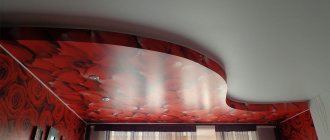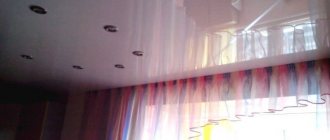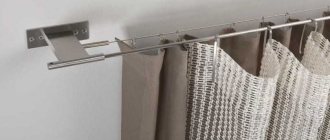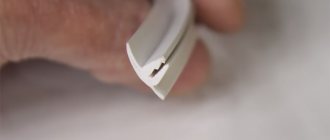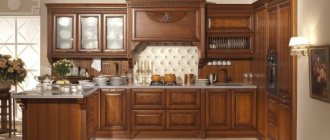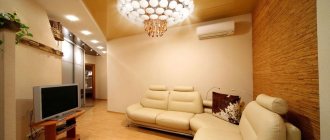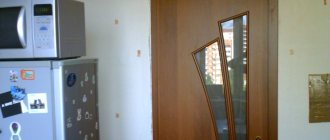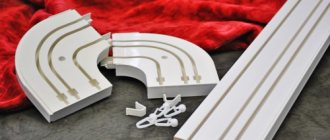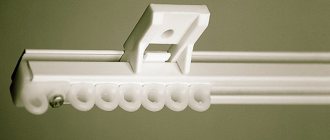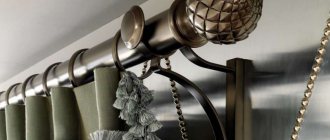Cornices for a house with a suspended ceiling
Two types of cornice designs are used with suspended ceiling systems. Wall-mounted ones are attached directly to the walls of rooms. Their installation can be done when the blade is already secured, although preparatory drilling work can be done in advance.
With ceiling mounting everything is more complicated. It may require an embedded beam or a niche in the recess of which the cornice system will be hidden.
A hidden cornice for a suspended ceiling is more difficult to install and requires more expense, but it looks so impressive and changes the proportions of the home that the result is worth the expense.
Features of installation work
Built-in and open cornices on suspended ceilings are installed in different ways. If you are unsure of your own abilities and lack the necessary construction experience, in order for the installation of a ceiling cornice on a suspended ceiling to be successful, it is better to invite professionals to do the work. Such procedures must be implemented sequentially and slowly, otherwise an important detail may be missed. For those who decide to carry out installation themselves, it is recommended to strictly adhere to the relevant instructions. It is also important not to forget that the type of cornice for the tension system is selected at the design stage.
Open structures are mounted as follows:
- The future position of the cornice is marked on the rough base.
- A frame structure is installed and fixed to the walls.
- A wooden beam of identical length with a cornice is mounted. Its thickness should be such as to ensure that the element adheres to the wrong side of the tension fabric. The beam must be well prepared before installation, removing all irregularities and roughness. The wood is covered with antiseptic impregnation to protect it from damage by fungus and mold.
- The canvas is stretched. Before this, it is equipped with protective rings with niches made inside for twisting. Holes are made using the burning method, which makes it possible to melt the edges of the film.
- To fix the cornice structure to the beam, self-tapping screws are used. It is necessary to ensure that the screws fit exactly into the holes in the film. In case of an error, a “arrow” may appear on a delicate surface, which over time will grow over the entire area.
The procedure for installing a cornice inside a niche:
- The plank is fixed to the rough ceiling, according to the previously applied markings.
- A beam is mounted close to the cornice using clamps. To achieve masking of the cornice, it is important to choose the right height.
- Having installed the clamps for the film on top of the beam, the fabric is stretched.
- During work, the same precautions must be taken as in the case of an open structure.
- If the fasteners are installed on a bay window, each break must be equipped with only a solid block. This will make it possible to achieve maximum reliability of fastening the screws.
For the manufacture of beams, it is necessary to use only high-quality solid wood bars. Otherwise, during operation, delamination of the surface may occur, which will reduce the reliability of fastening the screws. To avoid damage to the tension film, before installing it, cover the back of the beam with masking tape.
Types of closed installation of cornices
The structures holding the curtains can be made invisible, then they will come out directly from the ceiling surface. Visually this increases the height of the room, giving it special beauty and charm. Moreover, you can hide both ceiling and wall versions of cornices.
You can get this effect using a niche device. To do this, an indentation is made from the wall on which the window is located. It is calculated depending on the type of model and the width of the curtains when folded, since the folds should not be wrinkled and touch the ceiling fabric with each movement.
Usually this is a distance of 10-20 centimeters to the embedded element, where the fastening of the tensioned ceiling surface ends.
Most often this is a wooden beam, but sometimes a special lightweight metal profile is used. In the resulting niche you can place any system for curtains, with a mechanical or manual method of sliding.
Types of cornice designs
The choice of curtain rod depends both on the type of curtains and on the design as a whole. If the installation of a stretch ceiling has already been completed, then there is only one way out - a wall-mounted cornice, not a suspended one. This option is not very convenient. Firstly, the walls should not be made of plasterboard, and secondly, a large gap will form between the ceiling and the window, because visually this will make the room lower, which is of great importance in small apartments.
When successfully used in the interior, ceiling cornices successfully complement suspended ceilings.
Important! It is necessary to think over the design of the curtains in advance, since the embedded parts will be installed in the main ceiling using self-tapping screws and dowels, before installing the suspended ceiling, so as not to break the seal later.
When choosing a suitable design, you should also think about the practicality of choosing curtains. For example, lush curtains with lambrequins or multi-level cascades will look better in the living room. For the kitchen, roller blinds or blinds would be a more reasonable option. And for the bedroom, light flowing fabrics and a hidden type of cornice are suitable to create the effect of floating airy curtains.
If you hang a ceiling rail across the entire width of the room, the curtains can be pulled apart on both sides of the window.
For suspended ceilings, the following methods of attaching ceiling cornices are possible:
- Open.
- Hidden.
- Combined.
The open cornice is attached to already stretched vinyl, so it is necessary to apply marks to the canvas. Special polymer rings will be installed on them for burning holes, through which a wooden beam will be attached to the base ceiling using dowels. The advantage of this type of design is that installation and dismantling in case of breakdown is not difficult. The visible cornice can be decorated with drapery made from the same fabric as the curtains. The advantage of the Euro cornice profile is that the space behind it does not require any hassle in modification and no extra costs.
You should first of all start from what you ultimately want to see in your apartment or house.
An invisible cornice is installed in a niche between the wall and the edge of the stretch ceiling. To do this, a wooden beam is attached to the main ceiling, to which, in contrast to the open type of structure, a metal body is attached to fix the canvas. You can also install a suspended ceiling in the niche that remains unfinished, which will give the structure completeness and look more aesthetically pleasing, but the cost will also increase significantly. You can make a plasterboard box and hide all the cables in it. Alternatively, you can seal the opening with decorative plaster, paste wallpaper, or simply paint it over, but this part will still remain hidden from view.
If the cornice was previously attached to the ceiling, there is no point in removing it.
Built-in installation increases the possibility of design solutions, as it can be given a round, wavy or U-shaped shape. The transition between the canvas and the curtain can be decoratively decorated with a baguette.
A stretch ceiling box will help you implement bold design solutions.
It is not recommended to use a hidden cornice for a kitchen, since it contains many indentations and hollows that will certainly become clogged with dirt and grease, and cleaning such a structure will not be easy.
Important! It is necessary to calculate the width of the niche for the cornice before installation, so as not to interfere with the free movement of the curtains.
It is important to select a suitable cornice even before you install the tension structure.
The combined type, as the name suggests, combines both of the previous ones, i.e. The cornice is attached to the canvas, but there is also a niche in which the lighting is mounted. Installing such a design takes longer and costs more, but this option looks impressive and expensive.
Important! The installation of the backlight should be taken seriously, since if the installation is unsuccessful, when the curtains move along the tracks, it can be damaged and burn out. Particular attention should be paid to the joints of the tires.
The illumination of the niche for the cornice looks very nice, which enhances the already present effect of air curtains.
Tire type of curtain rods
They can be made of aluminum or plastic and represent a guide profile, like a tire with grooves arranged in it for laying stretched strings. Curtains move along them using hooks or loops.
Rail curtain rods for curtains under suspended ceilings can consist of a different number of rows:
- single-row - used when it is necessary to zone the living space or as an addition to blinds;
- double-row - the most common, suitable for daytime tulle and nighttime blackout curtains;
- three-row - used in more elegant interiors, where the third row is occupied by a lambrequin, draperies or a second night curtain that overlaps the first.
The advantages of hidden cornices
Hidden cornices come in different forms: in the form of a recess behind the ceiling, which is not visible at all, and in the form of a separate box behind which the cornice is attached.
In both cases, the curtains look very elegant and you get the feeling that they are flowing straight from the ceiling. Of course, building such a cornice with your own hands is more problematic, but it is quite possible. And we will tell you how to do this below, in the corresponding block.
And the main advantage of this method is that you are free to make a cornice not just of a linear shape, but of any shape: wavy, radius, etc. It is absolutely impossible to achieve such effects with the help of ready-made cornices.
Profile cornices and their advantages
This type is the most reliable and common. Rugged aluminum or plastic construction is easy to install and durable to use.
It is a profile, straight or curved, with a guide structure along which hooks with curtains move. They can consist of several rows or be composed of several single rows.
Their weight is very light and does not create a deforming load on the ceiling or walls, especially when drywall is installed instead of plaster.
A variety of such curtain rods are flexible, which easily bend in any direction. They can be rounded at the edges or given a wavy shape just by fastening along a given line, which can be very convenient when designing unusual layouts and bay windows.
Manufacturing materials
The production of hidden ceiling cornices and suspended ceilings has been mastered by many domestic companies. Their assortment includes products that differ in both their design and raw materials.
To make a ceiling cornice on a suspended ceiling, the following materials are usually used:
- Plastic
. The most popular variety of products of this type, which is explained by their low cost and good strength. If the situation requires it, the plastic rail can be further strengthened: this will allow it to withstand more weight of the curtains. When choosing the color of plastic curtain rods, they usually focus on the shade of the tension fabric. - Aluminum
. These structures are more durable than their plastic counterparts. Their prices are quite cheap. Due to its flexibility, aluminum curtain rods for suspended ceilings can withstand heavy loads. The plasticity of the profile makes it possible to use it to design complex shaped windows - bay windows, French, arched. - Steel
. Metal varieties are the most durable, but their installation will require appropriate preparation. If even a beginner can handle plastic or aluminum products, then it is better to invite an experienced craftsman to install a steel cornice. These structures are characterized by durability and a complete lack of flexibility. Steel models are a good answer to the question of which cornice is better if the suspended ceiling is equipped with a straight niche. - Tree
. This material is the most expensive and difficult to install, so it is also recommended to entrust this work to professionals. Wooden models are characterized by heavy weight and bulkiness, which is why they can only be installed on solid floors using reliable fastenings. Models made of wood initially have a figured molding, which allows you to add additional originality to the interior of the room. Products of this type are quite capricious to the microclimate of the room: the temperature and humidity of the air should be at an average level, without strong fluctuations.
Quite often, in addition to the cornices, additional equipment is offered in the form of decorative elements. The most common of them is a bar with hoods. Most often, it is included in a set of plastic products, having the appearance of a small elongated step that masks the junction of the curtains and the cornice. In classic interiors, you can use polyurethane baguettes: they will cost an order of magnitude cheaper than carved wooden planks, while maintaining significant decorative properties. The external design of friezes can be different - from a modest smooth surface to patterns for stucco, gold trim, etc. In addition, polyurethane models are lighter than wooden ones and are not afraid of moisture.
Automatic way to control curtains
An existing mechanical system for controlling the movement of curtains can be automated if an electric motor or special sensors for combining with a remote control and telephone are built into it.
Then it will be possible to program the movement of the curtains by the clock, as well as control them using an electronic smart home program.
Cost of ceiling cornice
The price of ceiling curtains (cornices) depends on the material used.
The following types of curtain rods can be purchased in stores:
- A straight-shaped plastic cornice holder costs $1.4-18.2 per element with a length of 3 m. The exact cost depends on the number of strings and the number of clamps, runners and rings.
- Holders with rounded corner elements and a plastic strip cost $4-10/piece. In this case, the length of one element is 1600 mm.
- A straight cornice with a plastic decorative strip 1600 mm long costs $8-16. There are also longer parts that cost more.
- Metal holders are used for massive, heavy curtains made of thick fabric. The cost of such elements is in the range of 25-30 dollars with a length of 1600 mm. However, decorative tips are not included in the price and must be purchased separately.
- Flexible cornices are useful for creating partitions for functional zoning of a room or for constructing a canopy over a bed. Such parts cost 4.5-5.7 dollars per 3500 mm length.
For a specific stretch ceiling design and taking into account the parameters of the room, you can choose a suitable cornice element and method of its fastening. If selected correctly, this detail will harmoniously fit into the overall design of the room. Thanks to this, the room will become cozy and comfortable.
